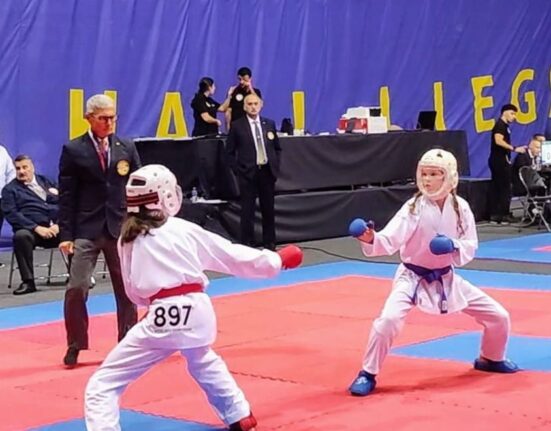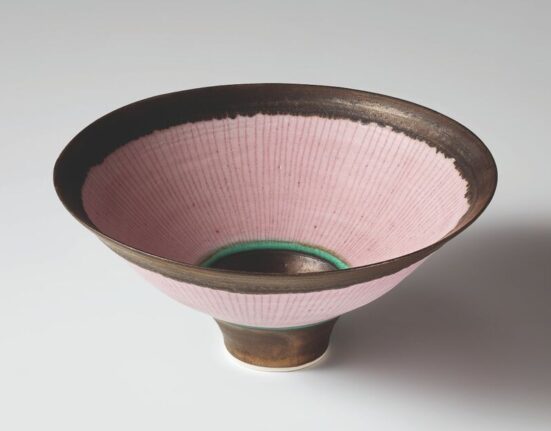Shota Nakamura thinks a lot about gardens, and people in them. “I couldn’t really tell why, but nature is always coming up in my paintings,” he said, during a recent tour of his Berlin studio. The bright space was dotted with canvases featuring these gardens—some flaming pink and orange, others a murky mix of blues and browns, mostly unfinished, the artist explained.
Nakamura’s recent shows at Berlin’s Peres Projects have each presented series of paintings depicting the outdoors, sometimes within a dreamlike, mystical haze, and populated by anonymized figures sleeping, meditating, or reading. In particular, “each passing day,” his second show with the gallery, which took place in 2022, showed portal-like paintings that open up calm, patchwork landscapes, populated by figures at rest. In July, C L E A R I N G announced it would begin representing Nakamura, and his first solo show with the gallery is planned for early 2024 in Los Angeles.
Portrait of Shota Nakamura in his studio. Photo by Daniel Farò. Courtesy of Shota Nakamura.
Shota Nakamura, night drawing, 2022. Courtesy of the artist.
In Nakamura’s studio, a huge table was piled with scraps of paper: printouts of reference works, art books, and his own photographs, all materials for the new show. This table, he explained, tells the story of how he works: “I develop my practice by doing research on imagery—paintings, films, any kind of two-dimensional images. Based on those, I can imagine how I want to develop [the works] from that.” Mixed in with these references were preparatory paintings, small canvases that retain the artist’s earthy, muted shades in a contrasting and thoughtful palette.
Nakamura selects elements of these paintings that resonate with his mood and curiosity, which he wants to expand into a larger painting. “I like that touch, for example,” he said, pointing to a particular spot on one of his small, brightly colored canvases. “Line-making, color testing, it’s just intuitive working,” he said. This experimentation, always with paint but applied in different textures (thin washes in some places, thick daubs elsewhere) is his core practice, he explained. “It’s almost like collecting the images, encountering the images…it’s more joyful,” he said.
Shota Nakamura, Untitled (the garden), 2022. Courtesy of the artist.
Portrait of Shota Nakamura in his studio. Photo by Daniel Farò. Courtesy of Shota Nakamura.
Nakamura pulled another image, this one by French painter Suzanne Valadon. It shows a person bathing, alone in a garden, a house behind her; the wild and abundantly green garden flourishes in every corner. One of Nakamura’s preparatory canvases in progress nearby took the same composition: house, person, garden, all from the same viewpoint. “You look at her and try to engage with her, but you don’t know what she’s thinking,” he said. “I like that aspect, that she’s so absorbed in the space, that’s exactly how I feel when I’m in nature.”
Perhaps it’s unsurprising that Nakamura would take such inspiration from the natural world: He grew up in the mountainous splendor of the Yamanishi prefecture, close to Mount Fuji in Japan. While studying at Musashino Art University, the artist realized that his favorite contemporary Japanese artists—most notably Yoshitomo Nara and Hiroshi Sugito—had spent time in Germany. After he graduated, in 2012, he decided to follow in their footsteps, ultimately settling in Berlin.
Photo by Daniel Farò. Courtesy of Shota Nakamura.
Shota Nakamura, walking, 2023. Courtesy of the artist.
Though he lives in a city, Nakamura stays close to nature, going on daily walks through the green spaces of Berlin, sometimes taking photos for inspiration. “I go to the park every day, and try to channel my moods, to really have a dialogue with myself,” he said. “I’m really interested in the state of the mind that’s very quiet, when you try to create a very personal connection with nature. It’s a meditative process.”
Though he followed the career of these Japanese painters, Nakamura’s constant touchpoints for his practice are French and European modernists—Picasso and Matisse in particular, as well as Les Nabis. On his desk is a thick tome on Pierre Bonnard, one of the best-known artists from this early 20th-century group and a clear reference point for Nakamura’s paintings, both in subject matter (domestic interiors and gardens) and style.
Bonnard often focused on domestic scenes that spill into the garden in his paintings—a frequent subject for Nakamura, too. For example, in SUMMER TABLE (2023), the artist creates an expansive, verdant background for a group of diners around a table, each lost in their own thoughts. In the foreground, vines poke up in front of their clouded faces—a sign, perhaps, of nature forcing its presence in the social world of human thought.
“I’m always interested in the in-between space, in a way: interior and exterior, indoor and outdoor, the domestic and outside,” he said. For him, the interior represents the world inside his mind; his paintings of these liminal moments represent an attempt to peer out into what’s outside his own mental world. “My mind is like a room; trying to get out of the room, you are looking outside, through the window,” he said.
Shota Nakamura, Goldfish bowl on the table, 2022. Courtesy of the artist.
In Nakamura’s world of painting, the canvas becomes a metaphorical space where domestic objects become charged with meaning. “A table is also a metaphor for painting, where you can create your own space,” the artist pointed out. “And around the table are people, who are not actually the main subject.” This attitude towards portraying people is crucial for Nakamura, who has an ambivalent approach to his human subjects. “I always had a problem with painting people. I felt like they were taking over the entire painting, and I didn’t know how to deal with that,” he said. It was only when he started portraying people sleeping, or reading, that he became more comfortable with the denizens of his nature-inspired painting. “I find that this is okay, because the body is present, but the mind is somewhere else.”
For Nakamura, these muted paintings are personal representations of a psychological state, the feeling of stillness in nature, which he hopes to replicate by the act of painting itself. He points to another of his unfinished paintings hanging on the wall, which has a different reference image sellotaped next to it: a Chinese ink painting, a multitude of brushstrokes, crosshatched into a mountainous landscape. It’s this restful focus that Nakamura is both portraying and enacting: “When I’m touching the painting, I have a meditative connection with it,” he said.
The Artsy Vanguard 2023
The Artsy Vanguard is our annual feature recognizing the most promising artists working today. The sixth edition of The Artsy Vanguard features 10 rising talents from across the globe who are poised to become the next great leaders of contemporary art. Explore more of The Artsy Vanguard 2023 and browse works by the artists.
Josie Thaddeus-Johns
Josie Thaddeus-Johns is an Editor at Artsy.
Header: Shota Nakamura, from left to right: “Goldfish bowl on the table,” 2022; “Untitled (green room),” 2023; “calm night,” 2022. All courtesy of the artist.




